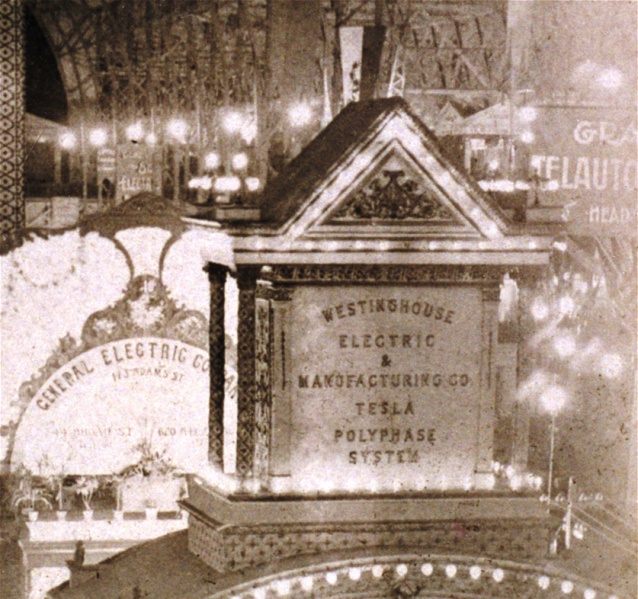File:TeslaPOLYPHASEColumbianEXPO1893rwLIPACKownerA.jpg

Original file (837 × 786 pixels, file size: 882 KB, MIME type: image/jpeg)
TESLA POLYPHASE SYSTEM is unveiled to the world at Chicago's Columbian Exposition, 1893.
While still a student attending school in 1875, at Austrian Polytechnic in Graz, Austria, Nikola Tesla began to think about the possibilities of alternating current or "A.C." electricity.
It was understood that A.C. electricity could generate high voltages over long distances without growing weaker, but little work had been done in that area. The field of electrical engineering of the day was primarily entrenched in the realm of "D.C." or the principles of direct current electrical generation and transmission. Tesla became thoroughly convinced that A.C. was much more effective and less costly than direct current D.C. electricity, the latter which was far more common at the time.
After graduation from school at Graz, Tesla went to Paris and began working for the Continental Edison Company, but in 1884 decided to go to New York. Upon arriving there Tesla immediately applied for a position with Edison's company. The great inventor Edison recognized Tesla’s abilities, but because of Tesla's preoccupation with arc light technology, Edison did not want to support Tesla's work in this area. Edison felt that arc lights were old, cumbersome and antiquated. Thus, in 1886 Tesla broke away from his position at the Edison concern and founded the Tesla Electric Company. This effort funded Tesla's arc light experiments. With this move Tesla was able to return to his A.C. experiments as well and within two years had applied for more than thirty patents on the A.C. system he had perfected.
Tesla eventually became associated with George Westinghouse, who had made a fortune producing the Westinghouse air brake for rail way cars. In 1881 Westinghouse began to experiment with A.C. electrical systems, after obtaining already manufactured equipment out of Europe. In 1886 the inventor Nikola Tesla demonstrated a polyphase brushless AC induction motor also based on a rotating magnetic field. In July 1888, George Westinghouse licensed Nikola Tesla's American patents for the induction motor and transformer designs. Tesla contract with Westinghouse turned over A.C. development and patents to the Westinghouse Corporation - and thus Tesla became wealthy from this keen business move. In 1893 the Westinghouse Company came to supply all lighting for the Chicago World’s Fair / Columbian Exposition and introduced and employed the Tesla designed Polyphase system, including the engine, dynamo, and A.C. generator for the exposition fair.
With the success of Tesla's A.C. system, it soon became the preferred method of generating electricity worldwide. Tesla worked on a number of other inventions, including a transformer that would change a low voltage to a high voltage by means of safe A.C. electric current. This transformer came to be known as the Tesla coil.
The scene depicted herein shows the interior of the Electrical Building at the 1893 Columbian Exposition, Chicago, Illinois.
Image is from an original glass magic lantern projection slide discovered by American historian and photography archivist Richard Warren Lipack.
File history
Click on a date/time to view the file as it appeared at that time.
| Date/Time | Thumbnail | Dimensions | User | Comment | |
|---|---|---|---|---|---|
| current | 09:04, 3 May 2014 |  | 837 × 786 (882 KB) | Richard Warren Lipack (talk | contribs) | TESLA POLYPHASE SYSTEM is unveiled to the world at Chicago's Columbian Exposition, 1893. While still a student attending school in 1875, at Austrian Polytechnic in Graz, Austria, Nikola Tesla began to think about the possibilities of alternating current o |
You cannot overwrite this file.
File usage
The following 3 pages use this file: